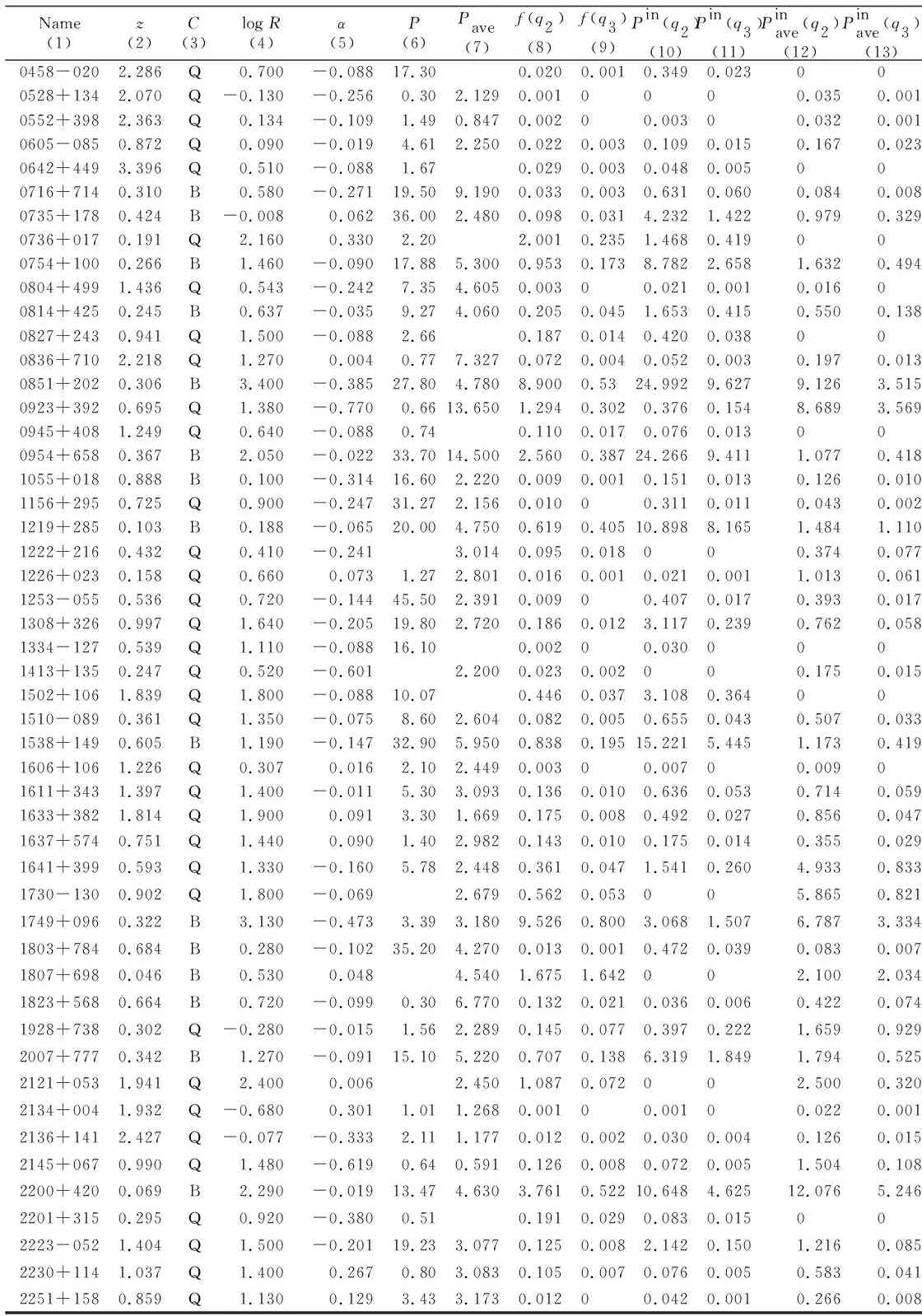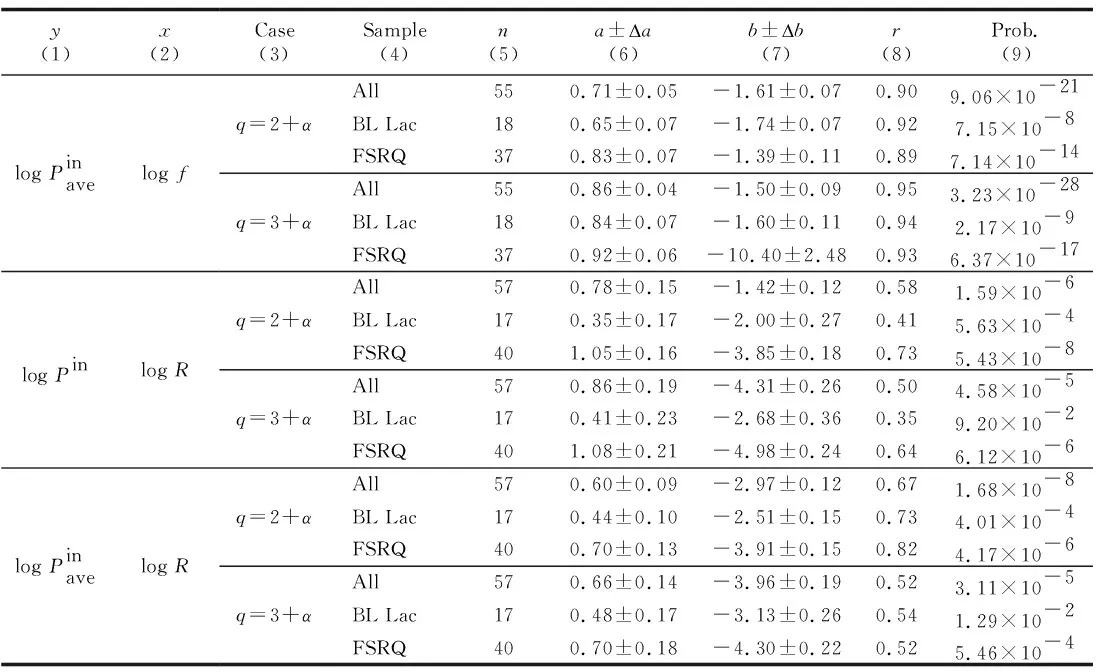Polarization and Core-Dominance Parameter for Blazars*
OUYANG Zhihao, FENG Huanjian, ZHENG Yini, ZHOU Zeping,XU Peishan, HE Sile,3,LI Yuntian, LUO Gaoyong,TUO Manxian, YANG Jianghe2,, FAN Junhui
(1. Schoolof Physics and Electronic Engineering, Guangzhou University, Guangzhou 510006, China; 2. Center for Astrophysics, Guangzhou University, Guangzhou 510006, China; 3. Astronomy Science and Technology Research Laboratory, Department of Education of Guangdong Province, Guangzhou 510006,China; 4. College of Mathematics and Physics Science, Hunan University of Arts and Science, Changde 415000, Hunan China)
Abstract:Radio and optical polarizations are collected for a blazar sample. The relationships between polarization and jet parameters are investigated. The analysis results indicate that (1) polarization in BL Lac is higher than in FSRQs, and the core dominance parameter R and the ratio f are both positively correlated with intrinsic radio and optical polarizations; (2) the jet type is spherical; (3) BL Lacs and FSRQs have a similar correlation between the intrinsic polarization and jet parameters (log R and f).
Key words:active galactic nuclei; jets; BL Lacertae objects; flat-spectrum radio quasar
Blazars are sub-classes of radio-loud active galactic nuclei (AGNs), showing some extreme observational properties: variable and high polarization, rapid variability, high energy γ-ray emission, superluminal motion, etc[1-9]. Blazars include two sub-classes, namely, BL Lacertae objects (BL Lacs) and flat-spectrum radio quasars (FSRQs). Whereas they are quite similar in their continuum emission properties, their emission lines have quite different features: FSRQs with strong emission lines while BL Lacs with very weak (or no) emission lines. Blazars can also be classified as low-synchrotron peaked sources (LSPs) with synchrotron peak frequency (νp) satisfying logνp(Hz)≤14.0, intermediate synchrotron peaked sources (ISPs) with 14.0 < logνp(Hz)≤15.3, and high synchrotron peaked sources (HSPs) with logνp(Hz)≥15.3[10-11]. In the current paradigm for an AGN, there is a supermassive central black hole, an accretion disk surrounding the central black hole, and a relativistic jet is emitted perpendicular to the accretion disk. The extreme observational properties of the AGNs can be attributed to a beaming effect.
As the extreme subclass of AGNs, blazars show high and variable polarization[12-15]. Generally, blazars show variable polarization and do not spend much time at polarization as high as 30%[14]. There are a few blazars showing polarization being higher than 35%: 0235+164 (43.9%±1.4% at V band[16]), 0851+202 (37.2%[17]), and 0735+178 (36%[18]). Polarization as high as 45.5%±0.9% was found at U band in 3C 279[12]. High polarization was detected from 3C 454.3 when it came up a brightness outburst in June 2016[15]. Wills et al.[13]found the polarization to increase with the core-dominance parameter. The polarization in blazars was found to be correlated with the Doppler factor and was proposed as an indication of the beaming effect[19]and was confirmed to be correlated with the core-dominance parameters[20]. In this work, we will study the additional correlation between polarization and core-dominance parameter.
1 Polarization and Core-Dominance Parameter

(1)
In the two-component jet model, the beamed emission corresponds to the core emission,Score, while the unbeamed emission corresponds to the extended one,Sext. Then, we can define a core-dominance parameter as:
(2)
From the definition of core-dominance parameter, when the emission from the receding jet is no longer negligible, and the viewing angle is large enough, then eq. (2) should be written as[1, 23]
R(θ)=f(Γ(1-βcosθ)-q+Γ(1+βcosθ)-q).
(3)
Thus we can deduce the equation of ratio
f=R(θ)/{[Γ(1-βcosθ)]-q+[Γ(1+βcosθ)]-q}.
(4)
The two-component model assumes that polarized emission,Sjp, only originates from the jet, while the emission from the extended region is not polarized (Sjup), and that the polarized and unpolarized emissions are proportional to each other[19], namelySj=Sjp+Sjup=(1+η)Sjup, whereη=Sjp/Sjup. In the observers' frame, polarization can be expressed as[21-22, 24]
(5)
(6)
wherePinis the intrinsic polarization. Eq. (4) means that the ratiofcan be calculated if the core-dominance parameter,R, Lorentz factor,Γ(or bulk velocity,β), viewing angle,θ, and spectral index,α, are known. The Lorentz factor and the viewing angle are unobservable but can be obtained from Doppler factor (δ) and apparent velocity (βapp) as shown in eq. (1). The core-dominance parameter,Rcan be obtained from VLBI observations, and the spectral index,α(Sν∝να) can be calculated by fitting the flux densities at difference frequencies. Hence, given Doppler factor (δ), ratio (f), spectral index (α), and polarization (Pobs),Pincan be calculated from eq. (5), andηcan be obtained byPinandffrom eq. (6).
2 Sample and Results
2.1 Sample
As described in the work by Fan[2], the ratiofcan be calculated for a source when its core-dominance parameter (R), Doppler factor (δ), and apparent velocityβare known. In 2017, Li et al. compiled a sample of 65 blazars with known apparent velocity, Doppler factor and core-dominance parameter, and obtained theirfratio[24].
In this work, we obtained radio polarization data from the data base of the University of Michigan Radio Astronomy Observatory (UMRAO) for 55 sources and the optical polarization is taken from the ref. [25] for 57 sources. In the UMRAO data base, flux densities and polarizations are given at three radio frequencies (4.8 GHz, 8 GHz, and 14.5 GHz). In this work, the averaged radio polarization at 8 GHz,Pave, is used. The polarization and the radio spectral index (Sν∝να) are taken from ref. [22, 25-26]. All the corresponding data is listed in col. (1~7) of table 1, where col. (1) gives source name, col. (2) redshift, col. (3) Classification for the source, B represents BL Lacs and Q represents FSRQs, col. (4) core-dominance parameter, logR, col. (5) spectral index of radio,α, col. (6) optical polarization,Popt, col. (7) radio polarization,Pave,radio.

Table 1 Blazars Sample and Calculated Results

Table 1 (Continued)
2.2 Results



Table 2 Correlation Analysis Results

Fig. 1 Plot of the Intrinsic Optical Polarization Against the Core-Dominance Parameter

Fig. 2 Plot of the Intrinsic Radio Polarization Against the Core-Dominance Parameter
3 Discussion
Blazarsare a special subclass of AGNs, and high and variable polarization is one of its observational properties. The relativistic jet model can explain the extreme observational characteristic of blazars[1]. Optical polarization in blazars was found to change with wavelength[12], and found to reach high value when the source is in a flare state[15]. Wills et al. found that the polarization increased with the core-dominance parameter for blazars[13]and was confirmed in the ref. [22]. In 1997, it was concluded that the polarization is correlated with the beaming factor (Doppler factor)[17].
Although there is no linear relationship between logfand logPob, there is a clear positive correlation between logfand logPinfor the whole sample and for the two subclasses. The slopes of these correlations are consistent with our estimated relationships[19]. These results indicate that the polarization of the blazars is affected by the beaming effect.
3.1 Average Values

From the optical polarizations listed in table 1, we found the average polarization in BL Lacswas higher than in FSRQs. For radio polarization, it was higher in BL than in FSRQs too. So, we have that the polarization in BL Lacs is higher than in FSRQs, it is because the ratiofin BL Lacs is higher than in FSRQs.
3.2 Correlations
For correlation analyses, based on formula (6), when logfis much lower than unit and we supposeηto be fixed for a specific classification, logPin can be expressed as:
(7)
So that we expect a linear correlation between logPinand logfwith a slope of 1.



Hence, for both BL Lacs and FSRQs, it can be concluded that whatever optical polarization or radio polarization, there is a close correlation between the intrinsic polarization and core-dominance parameter. But the sample is not big enough because of the calculation of ratiofdepends on 4 known parameters (core dominance parameter, superluminal velocity, Doppler factor, and radio spectral index). A bigger sample will be helpful for the discussions of the correlations.
4 Conclusions
In this paper, a blazar sample with radio and optical polarizations are collected. The correlations between polarization and core-dominance are investigated, and some conclusions are as follows.
(1) The intrinsic and observed polarizations in BL Lacs are higher than in FSRQs. The core-dominance parameterRand the ratiofare both positively correlated with intrinsic radio and optical polarizations.
(2) The slope of the statistical correlation between the ratiofand intrinsic polarization suggests that the jet is spherical in our sample.
(3) BL Lacs and FSRQs have similar correlation between the intrinsic polarization and core-dominance parameter (and ratiof).

